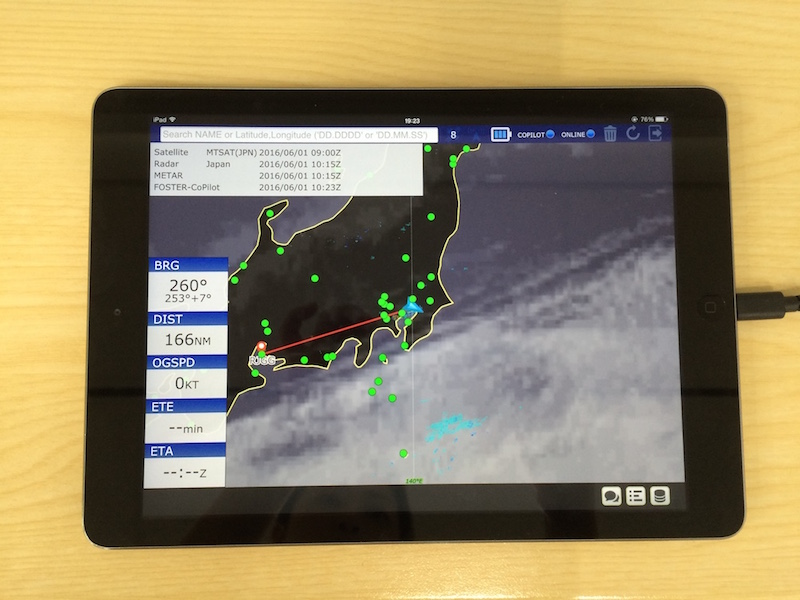News & Press Release
Weathernews works with Police Helicopters equipped with FOSTER-CoPilot in Medivac Earthquake Drill
Dynamic Management System for Medivac, Police, Fire and Rescue Helicopters
Aviation >Weathernews Inc. (Chiba, Japan; CEO: Chihito Kusabiraki) participated in the 2017 Medical Operations Drill in the Event of a Major Earthquake, which assumes a Nankai Trough Earthquake, on July 29th. The Weathernews proprietary portable helicopter dynamic management system FOSTER-CoPilot was used not only on medivac helicopters during the drill but also on police helicopters, and by sharing position information of the fire and anti-disaster helicopters, cooperative medical evacuation training was effectively conducted between different agencies. The messaging function of FOSTER-CoPilot was also used to share the latest weather information and projected impact time between ground crew and helicopters in real time. Weathernews will continue to support safe and efficient helicopter operations and medical evacuations in times of crisis.
Weathernews Helicopter Dynamic Management System used by select agencies during the 2017 Medical Operations Drill in the Event of a Major Earthquake
Following the Great East Japan Earthquake, medivac helicopters, ambulances and other medical vehicles were deployed to the disaster area from all over Japan. However, unified confirmation of the position and operability of each helicopter and ground vehicle by the various participating agencies was difficult which prevented an organized cooperation effort from being conducted.
On July 29, 2017, the Medical Operations Drill in the Event of a Major Earthquake was held in Mie Prefecture, Osaka Prefecture, Hyogo Prefecture and Wakayama Prefecture, which simulated the occurrence of the Nankai Trough Earthquake had occurred. This drill involved nine medivac helicopters and one police helicopter which were equipped with FOSTER-CoPilot on board, allowing unified management of each helicopter position in consideration to the current weather situation. In addition, an interface with Japan Aerospace Exploration Agency (JAXA)’s D-NET system enabled display of fire and rescue helicopter positions on one platform.

On the day the drill was held, high humidity and ample atmospheric instability allowed for isolated thunderstorms to develop in the training area which posed risks to helicopter operations. At the disaster management headquarters, the Staging Care Unit or SCU, which is a wide area temporary medical transportation base, as well as base hospitals used the Weathernews’ Go or No-Go decision support tool FOSTER-GA to display position data from FOSTER-CoPilot along with weather information in order to make effective decisions to ensure safe flights and determine which helicopters could be used for medical evacuations.
Useful in Wireless Blind Spots and Mass Messaging in Times of Disaster
Weathernews developed Japan’s first inexpensive, compact and portable helicopter dynamic management system FOSTER-CoPilot in the summer of 2012. At present over 90% of Japan’s medivac helicopters use the system for safe and fast medical transport.

In the summer of 2014, the two-way communication function of FOSTER-CoPilot enabled text messaging between the ground and the helicopter in-flight. This allowed flight operation management to be possible over mountainous areas or over water where wireless connectivity radio signals are weak. Not only can weather information be relayed from the ground to the helicopter, this function also allows the flight crew to send and receive urgent messages such as route and destination changes. As most helicopters operate under visible flight rules, weather conditions can easily restrict their operational areas. As a result, FOSTER-CoPilot’s functions to facilitate quick dispatch decisions as well as allow for two-way communication between the flight crew and ground are highly valued.
During the drill, messages were sent from the Nanki Shirahama SCU to six medivac helicopters and one police helicopter using the two-way communication function. Once thunderstorm activity was detected in the operational area, notifications were promptly sent to helicopters in-flight, demonstrating that this function is highly effective as a means of transmitting information in times of disaster.
First Drill After the Signing of the Agreement on Sharing Medivac Helicopter and Fire and Rescue Helicopter Positional Information
In March 2017, the National Hospital Organization Disaster Medical Center, twelve domestic medivac helicopter operators represented by Aero Asahi, JAXA and Weathernews concluded an agreement on sharing aircraft position information in times of disaster. This was the first drill to be held after this agreement came into effect. In the event of a large scale disaster, aircraft from multiple agencies are likely to participate, but in April 2016, at the time of the Kumamoto Earthquake, it took seven hours to get helicopter position data shared and displayed. During this drill, however, it took only thirteen minutes to share and display the positional information from the time the request came from the DMAT office. It was confirmed that quick and accurate information sharing immediately after a disaster has occurred is very effective for coordinating rescue operations and making operational decisions.


Weathernews has been serving the aviation industry for over 30 years. We will continue to develop and improve services to support the safe and efficient operations of helicopters.